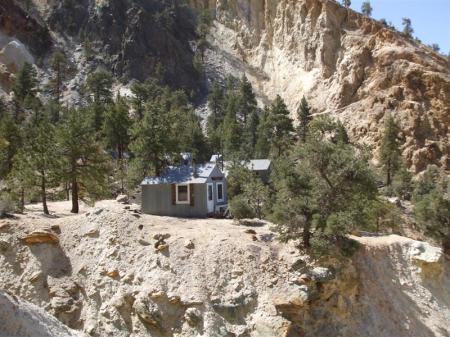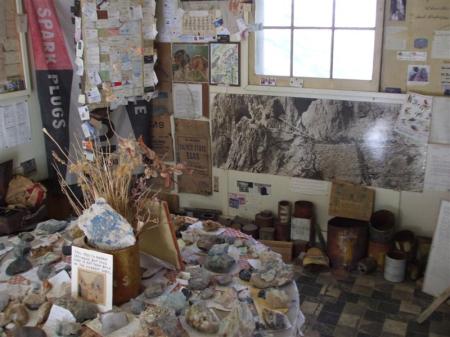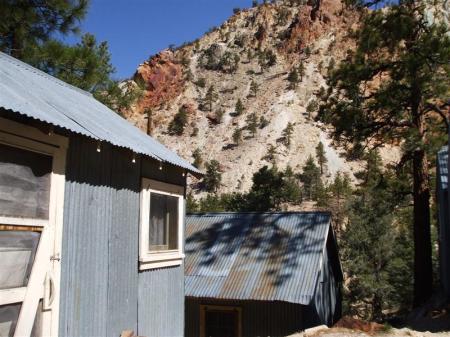Pine Creek Canyon is about as rugged as it gets in the Eastern Sierra. This is a place where a person could lose his life real fast in a fall or rock slide; there are places right off the trail that are death defying, It takes a sure foot and steady nerve to negotiate the trails of Pine Creek Canyon. The trailhead is 10 miles north of Bishop and about eight miles west of U.S. 395. The road passes through spectacular scenery on both sides with large granite and rust-colored shale and slate mountains jutting up. At the mouth of the canyon is the little village of Rovana, which gets its name from an amalgam of Round Valley and the Vanadium Ranch. Rovana was 1940’s housing for the miners who worked in the Union Carbide mine up at the trailhead. Many a Bishop local grew up with fond memories of Rovana. 
At the trailhead I notice that things are still semi-primitive. No paved parking lot or permanent facilities are in existence. The trail goes right through the entrance to the pack station and heads for Pine Creek and Italy passes. A side trail goes up into an entirely different canyon to Gable Lakes. The old switchback road opposite the mine goes up to Morgan Lakes. Brian and Danika Berner are the owners of Pine Creek Pack Station. They are carrying on a tradition that goes back to the 1920’s and 30’s, when mules were used to pack in supplies to the tungsten mines and carry out ore. The tram towers that surround the canyon are a testament to what men and mules can do, and how they constructed the wooden towers in impossible places. Brian and Danika are long time Eastern Sierra locals who are wise, love the mountains and have respect for the environment. They come from an old, great Crowley Lake family.
The trail leaves the pack station and works its way up through a jungle of aspens, firs, and riparian plants. After about a half mile it joins the old mine road that climbs the steep hillside to the upper Brownstone mines. This trail is hot and killer in summer, and anyone who goes up after 11 a.m. is asking for heatstroke. There is very little shade, and dogs will expire. The road finally turns into a trail and traverses under the high tungsten mines. The scenery up this trail is absolutely mind-drooling insane. Waterfalls and multi-colored striated peaks are everywhere. It is rough and rugged and the steps are too high. This is not an easy hike that leads to Pine Lake and beyond. But what trail in the Sierra is?
In 1980 on a hike over Italy Pass from Pine Lake, I remember going through Granite Park and seeing these choice little creeks meandering down through perfectly manicured grassy meadows. The sand was white and the water had a pure bluish tint. Colorful flowers were popping up all over the place like a Galen Rowell photo. This place was heaven! I can still see the snapshot in my mind, and the wonderful thing is that the snapshot is no different today. My old buddy Slim Nevins, the Forest Service packer, told me he used to pack mules over Italy Pass when he owned Pine Creek Pack Station in the1950’s. There is no way a stock user could do that today. Those old guys, like Art Schober from Bishop, made trails and packed into places that are unbelievable. I consider it a great thrill to find these old trails that those men made that have gone back into history. Their legacy is a wonderful one that is cherished by their families to this day.
Italy Pass was stark, Italy Lake was stark, and I just wanted to get down through the Hilgard Branch into the forest at Bear Creek. Now I was deep into the west side of the Sierra. Deep into a comfortable scene of smooth granite, streams and forests. Places where many a native person had been long before me as evidenced by the artifacts they left on the ground. It was sweet, but I knew I had to go back over the hill and head for home.
That was just one way to go. I was going to hike up to Gable Lakes on a side trail. This trail goes up a steep rocky slope that has the look of avalanches, rock slides and flash floods. It has been closed before due to rock slides. I stood beneath a rock outcrop on this trail one time and watched slides come down on each side of me. It was too much and would have been instant death if not for the rock outcropping. The mountains are always unstable, and a slide can happen at any time for any reason. 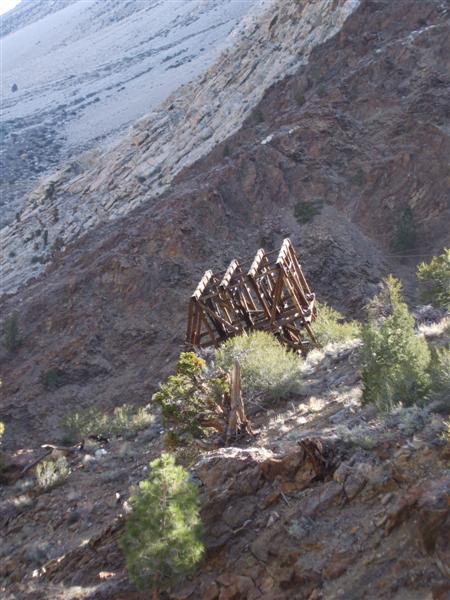
Off the Gable Lakes Trail are tram towers that carried ore in cars from the mines in the sky to the mill at the bottom. These towers that were built out of heavy timbers and packed in on mules, seem to hang out in space. The tram line was very scary to work on, because it is so high off the ground and had to be maintained year round.
Old miners like Jesus and Marcello, who worked at the Union Carbide Mine in the 60’s told stories about guys riding the tram cars up the hill, when they were coming back from town drunk. The tram cars would get sideways in a wind and jump the rail when it snowed heavily. Sometimes the guys were in the cars when this happened.
Jesus loved to tell stories about the buses that ran up the steep switchback road to the upper Pine Creek mines. Before the switchbacks were constructed they used to drive all the way around through Rock Creek Lake. “Most guys only lasted about a week riding the old gray bus up and down those switchbacks each day. One time in winter the bus started spinning wheels with chains on and rolled back ready to go off the hill. One pine tree saved our lives, and it was the only one on the road,” Jesus said, adding that a lot of guys quit after that.
No story about Pine Creek can be told without mentioning the tungsten mines. Joe Kurtak tells the story in his wonderful book, Mine in the Sky. This is a story about how a steel hardener called tungsten helped win WWII. Now the mine sits idle and waits for the future to claim it. I for one am glad to see it defunct, because it used to smell awful, like rotten eggs, back in the old days, when they were still milling the ore. You could smell it all the way up at 11,000 feet, and it would make you sick hiking back down to the trailhead.
It sure is amazing how time can change things for the better or worse. The old man from the wilderness asked me to share this message with you. He said to take time out to reflect on Nature, because she is the wise teacher. Besides wisdom and respect this is what the mountains have taught me: 1. When the sky looks real ominous and black, she means business. Get off the mountain if you can. 2. Never camp under a large dead tree, because a wind could come from out of nowhere and take you out in your tent. It doesn’t even have to be a wind, as the tree could fall from old age. 3. Never camp in a wash because a flash flood could roll through. I have come across abandoned camps where the tenants fled during a storm at night. They don’t bother to retrieve their camping gear, because they are too busy telling horror stories at home. Stick a bear into that scenario and we are really having fun. Can you imagine a bunch of people yelling and running out of their tents in a rain storm in the middle of the night chased by a bear?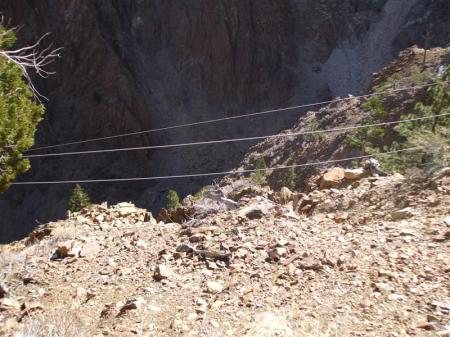
Speaking of bears that reminds me of the time I was out camping with the wilderness crew from Mammoth. My old trail partner, Sue Farley, was there among other notables. Sue is a woman after my own heart. She has been there, done that, can do it all, and then some. I knew that I had pitched my tent too close to the other folks at camp, when I had to get up in the middle of the night. The dogs went off, the flashlights came on, and someone said, “It’s a bear!” Then I heard Sue say, “That’s no bear; it’s a bare ass in the woods!”
Well, it sure has been a lot of fun sharing with you some stories about one of my favorite places in the Eastern Sierra: Pine Creek. Until I write again, I hope you find happiness along the trail of life.
